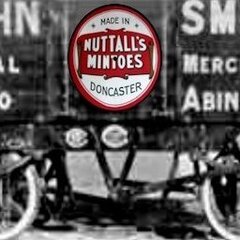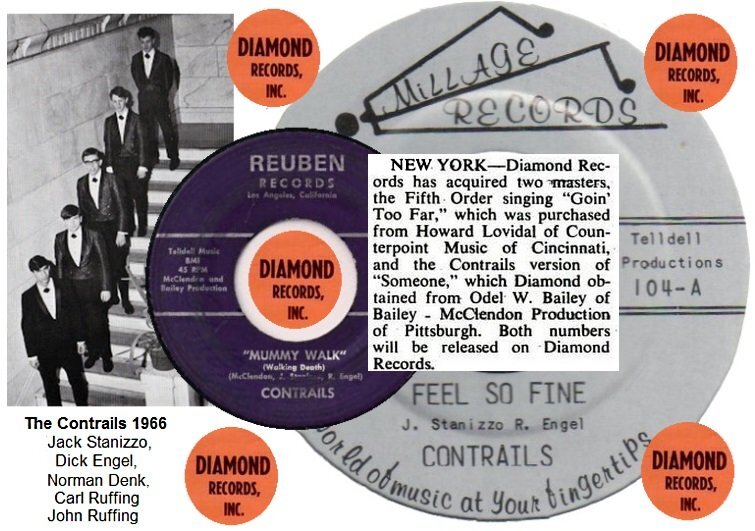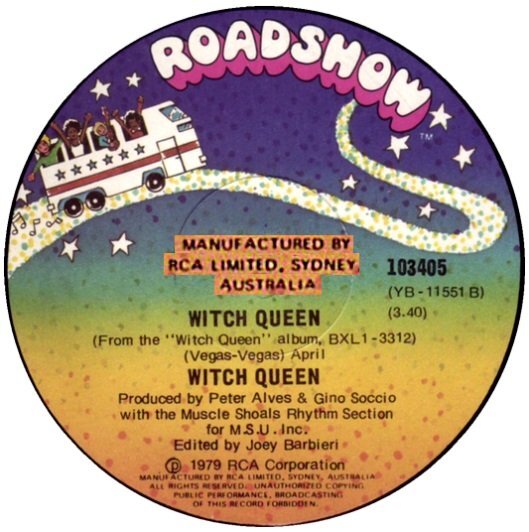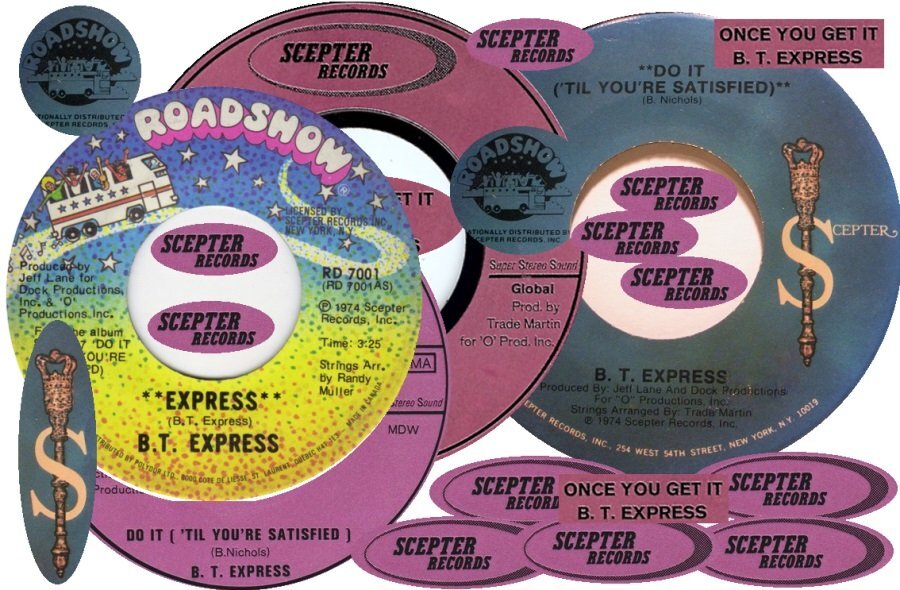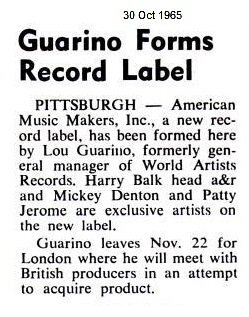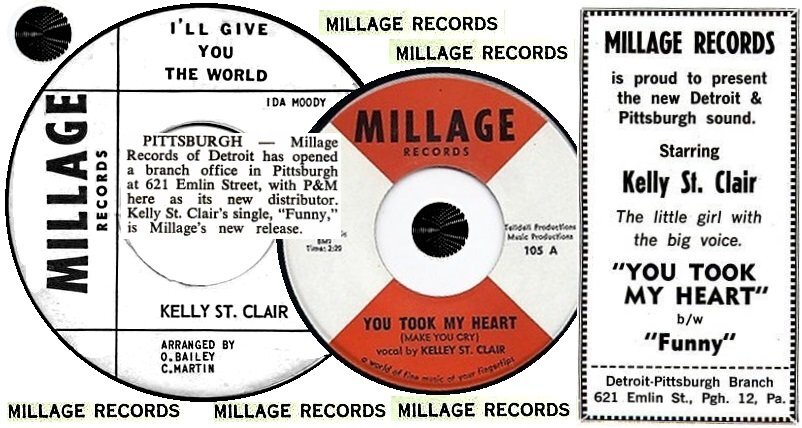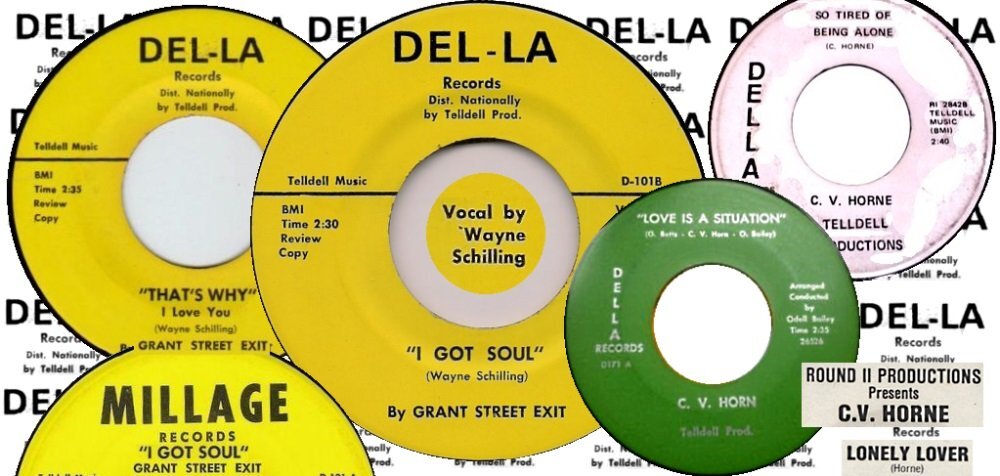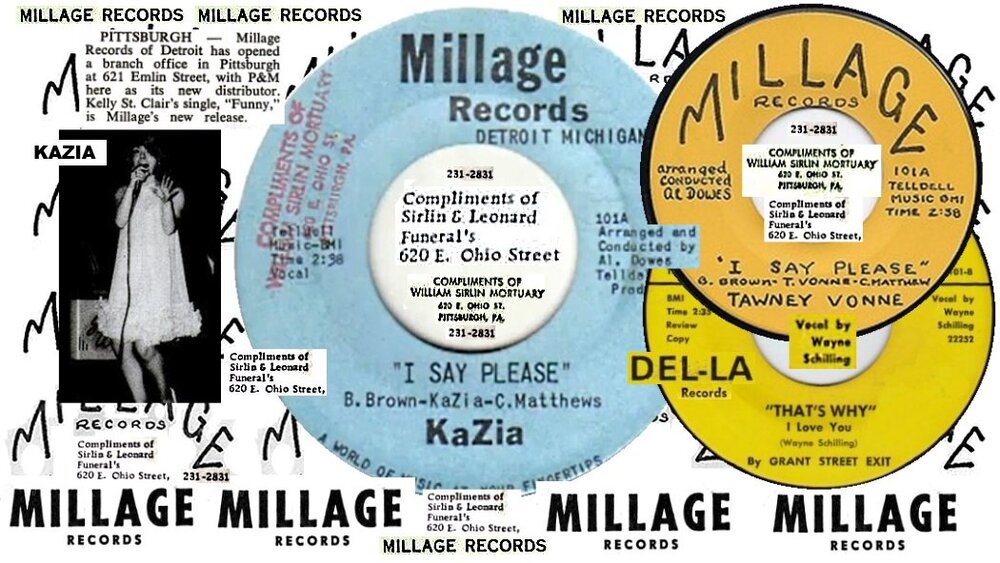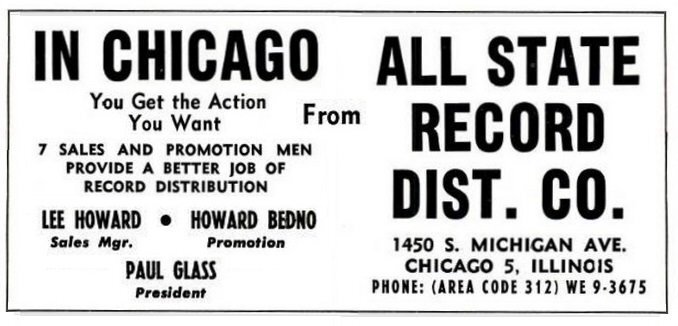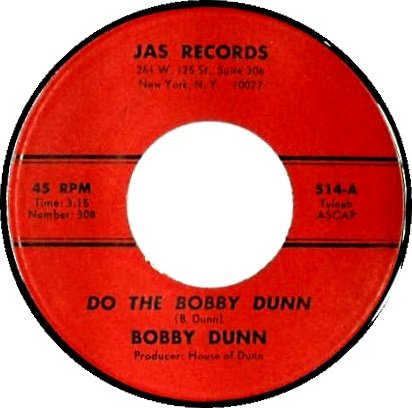Everything posted by Roburt
-
Soul Trivia
I'm suprised that she didn't call it Dusty ... ..... coz her & Dusty Springfield got to know each other when they both appeared at the 1965 San Remo Song Festival (Petula Clark was also on there that year). BTW, Ben E King and Peggy March were on the year before (64). I guess the San Remo Golden Strings were on every year at 'Festival Time' ..... .
-
Millage Records
When Diamond Records picked up the Contrails "Someone" in October 1966 (& released it at the end of that year), they licensed the 45 in from Bailey - McClendon Productions of Pittsburgh. So Odell Bailey still seemed to be operating out of Pittsburgh at the end of 1966.
-
Wonderettes
Here's the SDF thread I believe Robb is on about ............ ....OR ...... it could be this one .................
-
Don Downing - Dream World - What Label ?
-
Don Downing - Dream World - What Label ?
Roadshow Records was a label that operated in the US from 1972 to 1979 ......... https://www.discogs.com/label/Roadshow For a spell, Scepter distributed the label in the US and some of the 45's were put out on Scepter itself with a Roadshow 'badge' at the side of the label. Don Downing was the first artist to have a release on the label but quite quickly, the likes of B T Express & Enchantment signed up and had big hits for the label. B T Express had three R&B Top 10 hits released on Roadshow (2 of which made #1) and Enchantment had two R&B Top 10 hits on the label (1 making #1). Shirley Caesar & Al Wilson joined the label later on. It seemed to just be an outfit that signed up acts from across the States rather than being a label that developed its own acts. Stuff from the label was also released abroad, much on Pye International here in the UK. However, there were Canadian & Australian versions of the label that put out its product in those countries.
-
Millage Records
It's Millage that claimed to be a Detroit label ..... Steve Marriotts pre-Small Faces group (the Moments) were on World Artists not Millage. Lou Guarino worked for Odell Bailey's Varbee label, then he worked for World / World Artists / American Arts (that Detroit's Harry Balk was also involved with). Lou G quit WA to start AMM (American Music Makers) and fetched Harry Balk across with him (though that partnership seemed very short lived). Odell Bailey returns to the picture and starts up Millage (in Pittsburgh but claiming to be from Detroit) and Lou G and his act have a release on Millage. So there are definite links (seemingly right through the 60's) between the Pittsburgh & Detroit music scenes, but that doesn't make Millage a Detroit label (though it claimed to be one). Mind you, the Small Faces / Detroit links are STRONG ... ... Steve Marriott was from Manor Park, East London. Manor Park is near Deptford, Deptford sounds a bit like Detroit (well they share 6 letters in their names) ..... The Small Faces cut "Every Little Bit Hurts", a Motown song ....... so the Small Faces & Detroit are closely tied.
-
Millage Records
At the time of the Kelly St Clair release (Millage # 105 -- Dec 67) the label was still claiming a Detroit connection ...........
-
Bettye Lavette - Right Outta Time
I know that Bettye wasn't very happy that it had come out (even though the backing on this version is a lot better than the original Motorcity version). .... mind you, her objection was a monetary one (she didn't receive a cent for the release).
-
Millage Records
There's a piece on the net about Acid Jazz recently putting out the previously unheard "Money, Money" track that featured (Steve Marriott's) Moments. Funny coz the track was released on a World Artists 45 way back in the day ....... (see the US 45 in this youtube posting) ....
-
Millage Records
Yes, that's the registered address for Telldell Music that BMI currently hold. HOWEVER .... there's an e-mail address that goes with it (that I guess relates to SCI Records), but that e-mail address is defunct. BUT, I seem to recall Dave Thorley saying that Odell Bailey passed away a few years back, so I doubt an e-mail address relating to him would still be current.
-
Millage Records
Telldell Music is registered with BMI ......... the details are .......... ODELL BAILEY (PRESIDENT) 13027 PEMBROKE RD. DETROIT, MI 48235
-
Any Book(S) I`ve Missed?
............. Another new book .................. Midnight Train From Georgia: A Pip's Journey ........ https://www.amazon.co.uk/Midnight-Train-Georgia-Pips-Journey/dp/0828324697/ref=sr_1_1?s=books&ie=UTF8&qid=1367857836&sr=1-1&keywords=Midnight+Train+From+Georgia%3A+A+Pip%27s+Journey ...... an extract ............
-
Millage Records
So there were two Millage # 101records (the Kazia & Tawney Vonne releases) .... PLUS ... a Millage # D101 & a Del-La # D101 (the Grant St Exit releases) ...... Guess Odell Bailey really liked the number 101. But I knew the Grant St Exit release had Millage connections .... it was the 2 Della releases by C V Horne that I was seeking any linkage to Millage for.
-
Bettye Lavette - Right Outta Time
Wasn't this a remixed version of a 90's IL track ??
-
Millage Records
Pete S, I'm sure you can help here ............. Lou Guarino made a start in the record business in 1959. At that time, he was working for Calico Records who were based out of Pittsburgh. The label went big that year with the Skyliners (led by Jimmy Beaumont) “Since I Don't Have You”. He was soon working for sister label Robbie Records and then with Marcy Joe (Marcy Jo) who enjoyed a national hit in May 1961 with “Ronnie”. He worked on another session with Marcy Jo and her new 45 brought Harry Balk into the picture as he helped organise her cuts being licensed for release on Jubilee Records. Guarino and his partner Lenny Martin then cut Little Maxine Simmons (“Since I Lost You”) for Odell Bailey's Varbee label in 1961. Another act Lou cut that year for Robbee was doo-wop outfit the La-Rells. Still with Lou in charge, more La-Rells cuts escaped on World Records and Robbee (Liberty picking it up for national release). In 1963, Guarino was working on more cuts that escaped on the World Records label (the label name would soon become World Artist), this time on tracks by Lou Christie. 1963 would also see Guarino visit the UK for the first time. He was talent scouting and signed up British duo, Chad & Jeremy. Also that year, Lou signed the Stereos and he sent them up to New York to cut "Good News" and "Mumbling Word" (released on a World Artists 45 in October 1963). The group would go on to cut for Hyde tracks (Ohio) and these tracks were picked up by Chess Records ("Stereo Freeze" --1967) and "I Feel Soul A Coming" --1968). Back in Pittsburgh, World Artists added a new label in 1964, American Arts and the likes of Bobbie Smith and the Detroit based Volumes were signed to the label (via Harry Balk). By 1965, World Artists were getting action with releases by the likes of Reparata & the Delrons, the Shevells and Lee Garrett (plus UK outfit, Chad & Jeremy). Mickey Denton also had a 45 (“One More Time”) out on World Artists in February 65.The label was living up to its name and people from the label (Lou G included) were visiting the UK and signing up British acts in the hope of landing more success off the back of the 'British invasion'. A UK act who got to enjoy a World Artist 45 release was Steve Marriott's 1st group, the Moments (the single never gained UK release). Another singer who it seems had involvement was the label was a young Phyllis Hyman, though what she actually did with them seems to be lost in the sands of time. Pete, what can you tell us about that release from Steve Marriott's The Moments group ?? Why did the cuts never escape in the UK after the Small Faces hit big ?
-
Millage Records
I'm sure Odell Bailey was involved with some Detroit recordings / labels .... BUT.... I think they dated from around 1970 and later. Does anyone know when he moved to Detroit ..... around 1967 I would guess.... .... though he still seemed to cultivate his Pittsburgh contacts up until 1968 at least. I have already sought Boba's input on the other 2 (later) Del-La / Della Records releases. These don't seem to have any Pittsburgh / Millage connections apart from the Telldell Productions credit. The artist on the 2 'later' Della releases was C. V. Horne ...... anyone know where he was from (Detroit perhaps) .... or when they date from (1970's maybe) .... C V Horne had a 3rd single out in 1984 and that was produced by a Buffalo based outfit.
-
Millage Records
A bit of an explanation regarding the Millage Records / Sirlin & Leonard Funeral Home situation ........... ..... with the passage of time / people involved passing away, I don't suppose we will ever get the full story .......... Lots of the Millage 45's that exist today have stickers on them that state either compliments of William Sirlin Mortuary or Sirlin & Leonard Funerals (both sharing the 620 East Ohio St, Pittsburgh address). It seems that many Pittsburgh funeral services staged between 1930 and 1973 were held or commenced at the William Sirlin Funeral Home on 620 East Ohio Street (before 1930, the firm operated out of a different Pittsburgh address). William Sirlin and Richard Leonard owned the William Sirlin Mortuary, Sirlin & Leonard Funeral Home and Duncan Heights Cemetery (all of which were located at 620 East Ohio Street). By the end of the 1960's / early 1970's the Sirlin & Leonard funeral business was in trouble. William Sirlin had been struck off for a period for 'abducting' a body from the county morgue. Sirlin was a good age by then and actually passed away in 1973. Richard Leonard then seemed to lose interest in the business, though in his will Sirlin left it to Leonard and his old secretary, Evelyn Schilling. Leonard & the Schillings allowed the cemetery to fall into disrepair, much to the distress of the families of folk buried there. When the first Millage Records 45 had been released in summer 1967, although the label on Kazia's single had claimed the label was Detroit based, requests for promo copies of the record were directed to the 620 East Ohio Street, Pittsburgh address. It seems that whatever the link was between William Sirlin, Richard Leonard, Odell Bailey or Lou Guarino will remain a bit of a mystery but the record company seemed to be operating out of the funeral home at that time. All of the Millage artists were based in Pittsburgh and their tracks cut there (at Gateway Studios). Odell Bailey had been born in Pittsburgh and had grown up there and owned a local record shop. He did however relocate to Detroit at some time. Al Dowe (who arranged the Kazia cuts) was a Pittsburgh trombone player who went on to run jazz quintets and own jazz clubs in the city. Before Odell Bailey (and Lou Guarino) were involved with Millage Records, they had worked with the Contrails (a five strong local white group). Odell Bailey didn't think that the Contrails first record release in 1966 would be given a fair shake by Pittsburgh radio DJ's if they thought their tracks were locally cut. So he put the 45 out on the Reuben label with an LA address. The ploy worked and the tracks got enough local airplay to get New York based Diamond Records interested. They licensed the 45 and put it out in November 66 (Diamond #213). An associated label to Millage was Del-La / Della. The label seems to have put out three releases, the first one sharing the same catalogue number as the initial Millage 45 (# 101). The 45 was credited as being a Telldell Production and featured Grant St. Exit performing “I Got Soul” c/w “That's Why I Love You”. This must have come out around the same time as the Millage releases, most Millage 45 tracks were noted as being Telldell Productions and were published by Odell Bailey's Telldell Music. Another probable link to the funeral business turns up here. The writer and lead singer on the Grant St Exit song “Thats Why I Love You” was one Wayne Schilling. No doubt, he was the son, or a close relative, of Evelyn & Robert Schilling. The other two outings on this Della Record label were from C.V.Horne. Millage Records just seemed to fade away sometime in early 1968. So my guess is that Odell Bailey had been friends with William Sirlin back in Pittsburgh and so made use of his premises to promote the Millage releases (perhaps he had sold his Pittsburgh based record shop by 1967 and so had no local base himself). With them having put out a 45 on the Reuben label some months earlier that claimed the record was released by a LA based label, perhaps Odell used a similar ploy when he put out the 1st Millage release (Kazia's 45). With a Detroit address, the 45 was likely to garner more radio plays in Pittsburgh and the surrounding area (as Detroit was the hot recording base back then). THANKS to Boba for the info on the two Della C. V. Horne 45's.
-
Any Book(S) I`ve Missed?
As cut-out book shop buys have been mentioned just above ...... I got the Ace Records book a couple of years back in an Oxford everything £2 book store. They had loads of copies & as much of what Ace puts out ain't soul, I just bought 1 copy so I could check it out. The quality of the printing etc is great, so even though it was only the 'black music' content that interested me, I went back for more copies. Needless to say, it had sold out in a couple of days. ............ UPCOMING BOOK ....... available to buy any day now ............. God, the Devil & James Brown - Memoirs of a Funky Diva BY Marva Whitney (R.I.P.). https://www.amazon.co.uk/God-Devil-James-Brown-Memoirs/dp/1904408575/ref=sr_1_1?s=books&ie=UTF8&qid=1367595560&sr=1-1&keywords=marva+whitney+god+the+devil+%26+james+brown
-
Compendium Of Rare Labels ?
..................... An old IAN DEWHIRST post copied across from another thread ........ it concerns the old Aaron Neville hit 45 ........ It's interesting how a major hit can kill an indie isn't it? I've often had old time American record guys tell me exactly the same thing. "Tell It Like It Is" sold a million and the company went bust. The company was probably ticking over just fine in the New Orleans and Southern markets but suddenly having to press 1,000,000 45's and distribute them across the USA in 1967 must have been a step too far. One record veteran told me that you always have to have the next hot record ready to go otherwise the distributors will try and stiff you on the current hit.
-
Brown Sugar The Game Is Over Was It Pressed
You'll be pissed by 9pm Friday night, so I'll just park you on the grass outside the caravan door & make better use of your bunk. Us OAP's need our beauty sleep you know.
-
Mario Biondi Meet And Greet
Bugga, I'm in London today & tomorrow. It's too soon to come back next weekend.
-
Compendium Of Rare Labels ?
A little LA indie label, Mark II, had a hit on their hands with the Romeos (who were actually the Packers) track "Precious Memories" .... ..... look at how many distributors they had to take on (bet loads never paid em for the 45's either) .............
-
Stop & Get A Hold Of ..... Carole Waller
Paul Glass (who owned / ran USA Records) was also in control of one of the biggest 60's Chicago based distributors of indie labels .......
-
News: The Billy Nichols Story
So Billy Nichols & the Soul Swingers were the backing band on the Bobby Dunn 45 "Do The Bobby Dunn" (JAS Records) as well ....... that was cut in 1966, so it seems that the Mr. Dunn 45 must have been a late 66 or 1967 release. BTW, the Bobby Dunn track has many admirers among funk fans (& it has been included on 'boot' funk comp CD's in the past) ........
-
News: The Billy Nichols Story
Billy Nichols got back in touch with me concerning the Mr. Dunn 45 ...... He states that ........... Yes that was me and my band, we did that recording but I don't remember the studio..... I met the father of the Dunn Brothers back in 1966, Bobby Dunn. We first recorded a 45 on him called "Do The Bobby Dunn",then he hired us to record his sons..... I last saw Bobby about two years ago and he now is a preacher.

